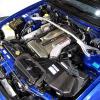R35gtr Tyres - Nitrogen Filling
Announcements
-
Similar Content
-
Latest Posts
-
This sounds do-able except space is a little tight were it's currently sitting. How many metres you reckon it would need to go?
-
I stick with Shannons through inertia and because they had to accept some things about insuring my car that they didn't really want to, but had to when their parent absorbed my previous insurer and forced me into their portfolio. I might struggle to convince anyone else to take that on for the moment.
-
There's no good RB25s lying around either. A blown RB20 is a good time to build it to take 35psi and give it a twin-charge using a nice screw compressor and a big fat turbo. Blower makes it act like a 3L and turbo makes that act like a 6L.
-
Reckon it'll be OK after 5 years? Running RB20s aren't $1k/free to good home like they used to be! Some might say a blown RB20 is a good time to move onto RB25 though...
-
You may well find that there is a big air bubble in there and plenty more coolant will be swallowed once it starts. So keep the bottle handy. If you can roll it back and forth, you can make the pistons go up and down a bit by putting it in 3rd or 4th and giving it a shove.
-




Recommended Posts
Create an account or sign in to comment
You need to be a member in order to leave a comment
Create an account
Sign up for a new account in our community. It's easy!
Register a new accountSign in
Already have an account? Sign in here.
Sign In Now